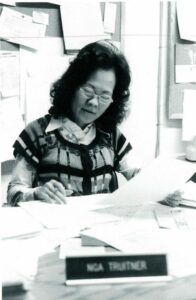50-year Refugee Resettlement Anniversary

May 6, 2025 | Fifty years ago, the Fall of Saigon officially ended the Vietnam War, marking a seminal moment in modern history. The exodus of hundreds of thousands of people seeking safety and freedom in Vietnam, Laos and Cambodia, among other Southeast Asian countries became a way forward for those who fled and those in the United States wanting to help.
On the other end of the world, the International Institute of Minnesota stepped up to assist those displaced, beginning a half-century-long commitment, eventually resettling over 26,000 refugees to our state.
In the decades since, the Institute became a leader in resettlement in Minnesota, and the United States cemented itself as the worldwide leader in refugee admissions. In January of this year, a presidential executive order suspended refugee admissions and the federal resettlement program.
How it All Began
On May 6, 1975, a family of 11 arrived from Vietnam, becoming the first refugees sponsored by the Institute. Since the law at that time greatly restricted refugee admissions, and a formalized federal program was not yet in place, resettlement relied on a community-based approach.
In Minnesota, this approach involved the Institute teaming with leaders from a range of social service groups, government agencies, faith communities and volunteers. Across the country, similar partnerships created an ad hoc approach to resettlement.
The ingenuity, resourcefulness and an altruistic spirit of these partnerships made resettlement possible throughout this period. However, due to the informal nature of the process, resources and assistance varied. The Refugee Act of 1980 streamlined resettlement and created a more equal disbursement of funding and resources.
 Back in 1975, much of the planning and preparations included Olga Zoltai, an Institute staff member and former refugee who strongly believed in the Institute’s ability to provide leadership. The Institute fundraised and planned for the influx of arrivals by hiring its first Vietnamese case worker, Nga Truitner, who quickly became an invaluable asset. Although her title was Case Worker, Nga became so much more than that as she provided emotional support, encouragement and even relationship advice to her clients.
Back in 1975, much of the planning and preparations included Olga Zoltai, an Institute staff member and former refugee who strongly believed in the Institute’s ability to provide leadership. The Institute fundraised and planned for the influx of arrivals by hiring its first Vietnamese case worker, Nga Truitner, who quickly became an invaluable asset. Although her title was Case Worker, Nga became so much more than that as she provided emotional support, encouragement and even relationship advice to her clients.
After surviving war, and being forced out of their homes, seeing someone like Nga who spoke their language and knew their customs provided comfort to the new arrivals. Nga and the Institute’s hard work did not go unnoticed, as Governor Wendell Anderson commended the resettlement efforts.
In 1976, a year after the first Vietnamese refugees were resettled, other groups negatively impacted by America’s military involvement in Southeast Asia began to make their way to Minnesota.
Leng Wong was the first Hmong refugee the Institute resettled, and within just four years, he was joined by 10,000 other Hmong individuals. Today, the Twin Cities has the largest Hmong population of any U.S. metropolitan area, according to the Pew Research Center.
 Once forced to move across the globe to a place with frigid winters and an unknown language, the Minnesota Hmong community has since become an essential part of the cultural and economic fabric of our state. From local and state elected officials to teachers, business owners, artists and U.S. Olympians; Minnesota has benefited greatly from of the half century of contributions from the Hmong community.
Once forced to move across the globe to a place with frigid winters and an unknown language, the Minnesota Hmong community has since become an essential part of the cultural and economic fabric of our state. From local and state elected officials to teachers, business owners, artists and U.S. Olympians; Minnesota has benefited greatly from of the half century of contributions from the Hmong community.
Institute Grows to Meet Needs of New Americans
In the decades since the Institute’s first refugee arrivals, the Institute has grown our services to meet the evolving needs of the New Americans being resettled. As the demographics and locations of displaced people changed, so did the Institute and our programs.
The Institute created workforce development programs to train New Americans for jobs in sectors that urgently needed workers, especially nursing assistants and health aides. The Institute has established itself as a recognized leader in New American workforce development and provides the support needed for immigrants and refugees to succeed and strengthen communities across the state.
Refugee resettlement continued to be an essential service the Institute provided before the program’s recent suspension by Executive Order. To prepare for an expected halt in refugee admissions following the new presidential administration, the Institute resettled over 900 refugees in the final 15 months of the program.
While we pause refugee resettlement, the Institute continues offering its comprehensive classes, job trainings and immigration services to New Americans already living in Minnesota. We will adapt, as we always have, to ensure New Americans are given the resources and services they need to be self-sufficient and strengthen our state.
As we honor the 50-year anniversary, we recognize the legacy and contributions of more than 26,000 refugees sponsored by the Institute since 1975 and that of other refugees who arrived through other charitable organizations and means.